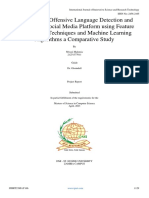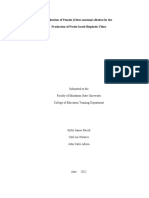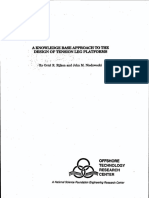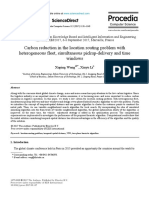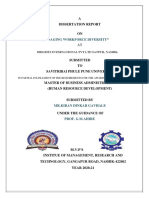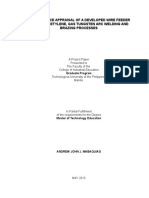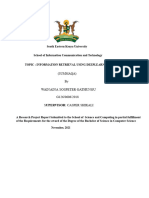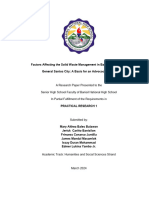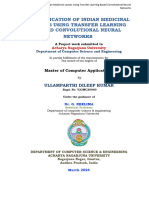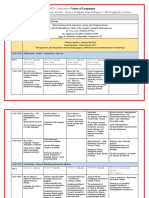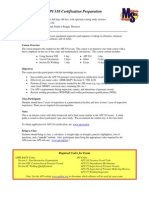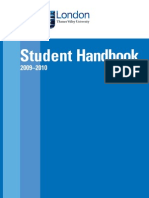Professional Documents
Culture Documents
Internet Connectivity and Academic Performace of BS Criminology in USST Colleges, Inc., Tarlac City
Copyright
Available Formats
Share this document
Did you find this document useful?
Is this content inappropriate?
Report this DocumentCopyright:
Available Formats
Internet Connectivity and Academic Performace of BS Criminology in USST Colleges, Inc., Tarlac City
Copyright:
Available Formats
Volume 8, Issue 4, April – 2023 International Journal of Innovative Science and Research Technology
ISSN No:-2456-2165
Internet Connectivity and Academic Performace of BS
Criminology in USST Colleges, Inc., Tarlac City
A Research Paper Presented to the
Faculty of the Graduate School
University of the Cordilleras
In Partial Fulfillment
of the Requirements for the Subject
Methods of Criminal Justice Research and Statistics
by
Heherson Balais
Joely Chrystele Dominggo
Marcial Meris Etong
December 2021
IJISRT23APR172 www.ijisrt.com 110
Volume 8, Issue 4, April – 2023 International Journal of Innovative Science and Research Technology
ISSN No:-2456-2165
TABLE OF CONTENTS
Title Page No.
TITLE PAGE 110
TABLE OF CONTENTS 111
LIST OF TABLES 112
LIST OF FIGURES 113
ACKNOWLEDGEMENT 114
ABSTRACT 115
CHAPTER ONE THE PROBLEM 116
Background of the Study 116
Theoretical/Conceptual Framework 118
Statement of the Problem and Hypotheses 119
Definition of Terms 120
CHAPTER TWO DESIGN AND METHODOLOGY 121
Research Design and Methodology 121
Population and Locale of the Study 121
Data Gathering Tools 121
Data Gathering Procedure 121
Treatment of Data 121
CHAPTER THREE PRESENTATION, ANALYSIS, AND INTERPRETATION OF DATA 123
Presentation, Analysis and Interpretation of Data 123
CHAPTER FOUR CONCLUSION AND RECOMMENDATION 127
Conclusions 127
Recommendation 127
REFERENCES 128
APPENDICES 129
A Questionnaire 129
IJISRT23APR172 www.ijisrt.com 111
Volume 8, Issue 4, April – 2023 International Journal of Innovative Science and Research Technology
ISSN No:-2456-2165
LIST OF TABLES
Table No. Table Title Page No.
1 Internet Connection Availability 123
2 Place of Internet Connection Usage 123
3 Kind of Internet Connectivity 124
4 Strength of Internet Connection 124
5 Reason for no Internet Connectivity 125
6 Devices Utilized During Distance Learning 125
7 If the students have no internet access at home 126
IJISRT23APR172 www.ijisrt.com 112
Volume 8, Issue 4, April – 2023 International Journal of Innovative Science and Research Technology
ISSN No:-2456-2165
LIST OF FIGURES
Figure No. Figure Title Page
1 Paradigm of the Study 119
IJISRT23APR172 www.ijisrt.com 113
Volume 8, Issue 4, April – 2023 International Journal of Innovative Science and Research Technology
ISSN No:-2456-2165
ACKNOWLEDGEMENT
The researchers would like to extend their warmest gratitude to the following who contributed to the accomplishment of the
study;
With utmost and sincerest gratitude, the researchers acknowledge the Almighty God who guided and provided the
researchers the strength to face every difficulty in the conduct of this study and for blessing them with wisdom and everything that
they utilized for the success of the study;
To the family of the researchers who are always there to support them spiritually, morally, emotionally and financially;
To MR. Robino D. Cawi, our professor for the subject that serve as our adviser for his invaluable assistance, advices,
support, guidance, encouragement and prayers to the realization of this study;
To the students of the USST College, Incorporated Station who served as the informant of the study, for sharing their time,
efforts, and experiences to serve as the references of the study;
To all mentioned and unmentioned names who shared their efforts in any kind for the success of the study, the researchers
express their warmest gratitude. You are part of this success and will always be part of their heart and memories.
IJISRT23APR172 www.ijisrt.com 114
Volume 8, Issue 4, April – 2023 International Journal of Innovative Science and Research Technology
ISSN No:-2456-2165
ABSTRACT
BALAIS, HEHERSON; DOMINGGO, JOELY CHRYSTELE and ETONG, MARCIAL M. University of the
Cordilleras, December 2021. Internet Connectivity and Academic Performance of Bs Crimininology Students at USST
Colleges Incorporated.
This study dealt with the internet connection status among the students of USST College, Incorporated student and
its relevance to their academic performance.
This study made use of quantitative approach. The participants of the research are 63 students from USST College
Inc.
Specifically, it sought to determine first the Availability of internet connectivity among the students; a. Where do you
frequently use the internet; b. What kind of internet connectivity are you using; c. How strong is your internet connection;
d.
Why there is no internet connectivity at home. Second will be the available devices do you use in online learning.
Lastly the effects of lack of internet connection in the academic performance of BS Criminology students at USST, colleges
The study showed the status of internet connectivity among the students of USST Colleges which are as follows;a)
Majority have internet connection. b) Almost all of them utilized internet at home, c) Big percentage have utilizing WIFI,
d) Average of internet connection among the participant is moderate, e) Mobile phone topped as gadget they use during
distance learning. It also showed that that majority of the criminology students who were enrolled in United School of
Science and Technology Colleges in Tarlac city agreed that lack of internet connection can causes the following factors to
their academic performance: a. failure to do their assignments; b. they.
Cannot access their lessons that was sent through their respective learning management system and messenger; c.
they cannot search for relevant ideas when making activities; d. they cannot watch video tutorials or pre-recorded
discussions; e. they cannot perform well during class discussion compared to those with internet access; f. they are not
updated with their topics in their online groups; g. lack of internet connection lessens their inquisitive thinking to learn
something new; h. they cannot relate to the discussion; i. low performance during recitation; j. low scores during quizzes;
k. late submission of requirements; l. Low score in practical activities.
IJISRT23APR172 www.ijisrt.com 115
Volume 8, Issue 4, April – 2023 International Journal of Innovative Science and Research Technology
ISSN No:-2456-2165
CHAPTER ONE
THE PROBLEM
A. Background of the Study
“Education is the most powerful weapon you can use to change the world” a famous line of Nelson Mandela denotes how
important education of transforming our place. Despite of the uncertain situation we are facing; the importance of education
remains to be consistent.
The pandemic has brought a major shock to our educational system but the important thing is that we do not stop on
delivering the education towards every student. Though our priority for now is the minimum health standards but for us educators
we never say no to education because of this pandemic.
On March 2020 The Director General of WHO declared Covid-19 as a pandemic after assessment of the rapid spread and
severity of the deadly virus across the globe with additional announcement of social distancing as a means of curbing the spread
of the pandemic (WHO, 2020).
In response with the spread of COVID-19 poses a threat to humanity, as this pandemic has forced many global activities to
close, including educational activities. To reduce the spread of the virus, education institutions have been forced to switch to
e-learning using available educational platforms, despite the challenges facing this sudden transformation.
In order to further explore the potentials challenges facing learning activities, the focus of this study is on e-learning from
students’ and instructor’s perspectives on using and implementing e-learning systems in a public university during the COVID-19
pandemic (Maatuk, 2021).
In connection with this Social distancing is conscious increment in the physical gap between people in order to curb
dissemination of disease (Red Cross, 2020).
Online learning is the use of internet and some other important technologies to develop materials for educational purposes,
instructional delivery and management of program (Fry, 2001).
The 21st century has brought about a massive change in the world of education. Gone are those days when teaching was
limited only within the confines of a classroom. The internet has brought about a paradigm shift in the fundamental way in which
learning is done. It has taken learning beyond the hallowed walls of the universities and into the palms of everyone. (Sarkar,
2020).
However, Tom (2017), stated that the concept of e-learning in not new for it can be trace back 170 years ago where
instructor/ professor sent task and receive assignment through email. This was the humble beginning of the concept of online
learning.
Long before the internet was launched, distance courses were being offered to provide students with education on particular
subjects or skills. In the 1840’s Isaac Pitman taught his pupils shorthand via correspondence. This form of symbolic writing was
designed to improve writing speed and was popular amongst secretaries, journalists, and other individuals who did a great deal of
note taking or writing. Pitman, who was a qualified teacher, was sent completed assignments by his students via the mail system
and he would then send them more work to be finished (Gogos, n.d.).
One of the first instances of online learning in the world can be traced back to 1960, at the University of Illinois, USA.
Though the internet wasn’t invented back then, students began learning from computer terminals that were interlinked to form a
network (Sarkar, 2020).
In addition, the Explore Talent LMS stated that, first online learning systems were really only set up to deliver information
to students but as we entered the 70s online learning started to become more interactive.
In Britain, the Open University was keen to take advantage of e-learning. Their system of education has always been
primarily focused on learning at a distance. In the past, course materials were delivered by post and correspondence with tutors
was via mail. With the internet, the Open University began to offer a wider range of interactive educational experiences as well as
faster correspondence with students via email etc. (Explore Talent LMS, n.d.).
In support, according to Sarkar on 2020, “the Open University in Britain was one of the first universities in the world to
begin online distance learning, in the early 1990s. Currently, the Indira Gandhi National Open University in India is the largest
university in the world with around 4 million students enrolled, most of whom currently receive education via online methods.”
IJISRT23APR172 www.ijisrt.com 116
Volume 8, Issue 4, April – 2023 International Journal of Innovative Science and Research Technology
ISSN No:-2456-2165
Online learning is the newest and most popular form of distance education today. Within the past decade it has had a major
impact on post-secondary education and the trend is only increasing (Stern, n.d.).
In transition, the term “e-learning” has only been in existence since 1999, when the word was first utilized at a CBT systems
seminar. Other words also began to spring up in search of an accurate description such as “online learning” and “virtual learning”
(Gogos, n.d.).
Online learning is education that takes place over the internet. It is often referred to as “e-learning” among other terms.
However, online learning is just one type of “distance learning” the umbrella term for any learning that takes place not in a
traditional classroom (Stern, n.d.).
According one research that is conducted by Merlot Journal in 2015 shows that there is strong evidence to suggest that
online learning is at least as effective as the traditional format. Online learning is a story that is still being written, and how it
progresses will likely depend on those present (Nguyen, 2015).
In addition, there are some advantages and disadvantages of online learning; the accessibility of online education globally,
saving time, money, and efforts are advantages of online learning. In teaching, the lecture’s recording is one advantage of online
learning when students ask teachers to record the classes.
The teachers are reviewing and preparing well for recording, which certainly improves teaching strategies and methods.
Students can access the lectures anytime and can understand better. Not all learners have good internet connectivity. Some
learners suffered from network problems, lacking high-quality learning devices (Mahyoob, 2020).
One of the challenge of this e-learning concept is the poor slow internet connection. According to one study, slow Internet
connections or limited access from homes in rural areas can contribute to students falling behind. The educational setbacks can
have significant impacts on academic success, college admissions and career opportunities (MSU, 2020).
The use of the Internet for learning is seen as a means to improve accessibility, efficiency and quality of learning by
facilitating access to resources and service as well as remote exchanges and collaboration (Kamba 2009).
Students with no high-speed Internet access at home are also less likely to plan to attend a college or university. On the other
hand, students with Internet access have substantially higher digital skills, which are a strong predictor of performance on
standardized tests (MSU,2020).
According to Ivwighreghweta (2014), internet has opened the door to a new way of learning. However, there is a challenge
brought by internet connectivity. Internet access it will become possible for users to browse within the environments and thus
enhance access to information needed specially to enhance academic performance.
Hiltz and Turoff (2005) argued that the contemporary transformation will be seen as revolutionary modifications in the
specifications of higher education as a process and as an institution in the next 50 years because the transformation has moved
face-to-face instructional programs using objectivist, for thousands of home-grown, provincial and domestic universities to online
and hybrid programs applying digital technologies in enhancing constructivist, learner-centered, cooperative pedagogy for some
hundred “mega-universities” that function worldwide.
In the Philippines, the term "e-learning" is used synonymously with online learning and concerns the online delivery of
instructional content as well as associated support services to students. This was used even before this pandemic, adopted on the
concept of Open University (Dela Pena, 2009).
Accordingly, university learning center to more extensive use of a learning management system (LMS) as a venue for
academic discussions as well as learning assessments, sharing learning resources and content, and students’ submissions of course
requirements.
However, in 2020, In the Philippines, this translates into almost 325,000 infected and 6,000 deaths (Worldometer, 2020). To
curb the spread of COVID-19, most governments have opted to employ quarantine protocols and temporarily shut down their
educational institutions. Among this number are over 28 million Filipino learners across academic levels who have to stay at home
and comply with the Philippine government’s quarantine measures (UNESCO, 2020).
To respond to the needs of learners, especially of the 3.5 million tertiary-level students enrolled in approximately 2,400
HEIs, certain HEIs in the country have implemented proactive policies for the continuance of education despite the closure. These
policies include modified forms of online learning that aim to facilitate student learning activities (Joaquin, 2020).
IJISRT23APR172 www.ijisrt.com 117
Volume 8, Issue 4, April – 2023 International Journal of Innovative Science and Research Technology
ISSN No:-2456-2165
The Philippine education system is struggling to adapt to the sudden and major shift to distance learning during the Covid-19
pandemic.
Over the years, the overall internet connection speed in the Philippines remains among the slowest in the Asia Pacific region.
That is despite having the highest average daily time spent using the internet in the region (Statistica, 2021).
In January 2021, the Philippines moved up to the 86th spot in the global mobile internet speed rankings, according to data
from an Ookla report. This is a marked improvement from its 111th rank in the same period last 2020 (DICT, 2021).
Slow internet connectivity hampers Filipinos in their work, streaming, and downloading of videos, which include the online
educational performance of the students (Statistica, 2021).
In support with the statement above a mother claimed that the only wrinkle to online learning is the intermittent internet
connectivity in the country. When there is an internet outage, children’s classes are canceled too (Dollanganger, 2021).
The numbers don’t lie. A poor showing in the study reflects the sorry state of connectivity in the Philippines, and this is
negatively affecting the lives of Filipino student’s (Esquire Philippines, 2020).
According to a news articles it state that “Truth be told, our country is an internet-challenged country. A problem that had
caused delays implementing remote learning in general. Although internet plans exist; they are not, however, created equal.
Hence, in online classes, there was never a day when a student hasn’t voiced out complaints such as “Can someone tell the
professor I/he/she got disconnected?” “Oops! Where did he go? (referring to the professor who doesn’t realize he got cut off),
“I have unstable Wifi”, “Do you guys see/hear me?”. We are in the city and yet we experience such mishaps. What more are
those students who are stuck in remote places where signal isn’t as strong as what we city dwellers have? They are forced to
“move mountains” just to get a bar or two” (Amadora, 2020).
Other factor to considered is the family situation, families who have more disposable income find themselves in a more
fortunate situation (Dollanganger, 2021).
Since the conduct of online learning, some of the BS Criminology students of United School of Science and Technology
(USST), Inc. encountered problems such as poor internet connectivity, power interruptions, and slowness of the platform used in
terms of fulling their academic requirements in their respective subjects. Furthermore, with the implemented online learning
system not all students have technological knowledge and significantly the resources. Some only rely on data connection and
others only use smartphones in attending their classes and in doing and submitting their academic requirements.
Having all these said, the researchers are convincing that the conduct of this study is indeed timely and relevant for the
Bachelor of Science in Criminology students of United School of Science Technology (USST), Inc. In this study, the main
objective is to measure the impact of internet connectivity in to the academic performance of the BS Criminology students of
USST, Inc., Tarlac City. It will be anchored by preliminary identifying the internet connectivity and access of the students and
then looking into the relationship of internet connectivity with the academic performance of the students in online learning.
Appropriate measures will be proposed as a result of this investigation that may potentially and positively impact the learning
experience of the BS Criminology students, instructors, and management of USST Colleges, Inc.
B. Theoretical/Conceptual Framework
Theoretical Framework
The academic setting was temporarily crippled worldwide due to the effect of pandemic, however, it does not hinder the
persistence of every learners and educators, thanks to the development of technology because we have the internet platform to
serve as a classroom for the students and educators.
This adaptation of the internet platform as an alternative for face to face class has been explained by the Uses and
Gratification Theory, wherein as a result of the pandemic the students and educators are in need of possible way to continue their
education, hence, they have utilized the internet platform to gratify their needs.
The result of this study will confirm if the internet platform can really gratify the standard of education especially to a
criminology student who were required to conduct practical exercises to gain the required knowledge in most of their courses.
The Observational learning theory can explain the positive effect of internet platforms towards the students because
educators are using online meeting which can be recorded and can be reproduced for the students to have further reference,
another is that educators can utilize the YouTube as their visual aid, hence students can download and review such recorded
discussions or video/s.
IJISRT23APR172 www.ijisrt.com 118
Volume 8, Issue 4, April – 2023 International Journal of Innovative Science and Research Technology
ISSN No:-2456-2165
The advantage of such approach is that the students can repeatedly view it until such time that it contents will retain to the
student’s mind and they can apply what they have observed.
Another is that the internet platform maintains a connectivity between the students and teachers, in relation, the
Connectivism theory explains that people will learn and grow when they have connection with each other.
As a result, the internet connection as one of the latest mode of communication helps every student in maintaining
connection with their teachers and vice versa. Hence, the study will further explain this connection between students and their
teachers as well as to discuss its effects and impact to their academic performance specifically the criminology students of United
School of Science and Technology Inc. in Tarlac City Philippines.
In addition, Salac and Kim (2016) claims that compared to other neighboring Asian countries, the Philippines has an average
internet speed of 2.8 Mbps whereas, Thailand had an average internet speed of 7.4 Mbps, Sri Lanka 7.4, and Malaysia 4.3, placing
the country at 104 among 160 countries, with developed countries in Asia such as South Korea (23.6 Mbps) and Singapore (12.9
Mbps) ranking 1 and 12, respectively. The poor quality of internet connection may cause delay or absences during classes which
will have a direct impact to the academic performance of every student.
In support, Jurado, et.al.,(2010) claims that limited internet access is a major concern in implementing blended learning,
whereas, Rotas and Chapay (2020) revealed in their study that there are twelve themes that causes difficulties as experienced by
the university student in the Philippines regarding the online learning system, and these are: unstable internet connectivity;
inadequate learning resources; electric power interruptions; vague learning contents; overloaded lesson activities; limited teacher
scaffolds; poor peer communication; conflict with home responsibilities; poor learning environment; financial related problems;
physical health compromises; and mental health struggles. One of these factors revealed in the study is the poor internet
connectivity, this only shows that from 2016 to 2020 the Philippine average speed of internet connectivity does not improve.
Furthermore, Bautista, J.(2021,Sept.20) Reported that with the current setup of blended learning due to the pandemic,
students have resorted to online cheating via a Facebook group where they share notes and test answers. The “Online Kopyahan”
community group has been created, and had at one point more than 600,000 members, but after a local television report aired, the
now-archived Facebook group was left with 571,900 members. This data shows that aside from internet connectivity, online
cheating will affect the academic performance of the students.
In addition, Singh (2014) concludes that most of the undergraduate students’ use the internet for entertainment, social and
education objectives. They use it minimum for their academics and knowledge.
Lastly, the aforementioned theories and concepts will be confirmed by the result of this study.
Paradigm of the Study
Fig 1 Paradigm of the Study
This study aims to determine the status of internet connection of the 3 rd and 4rth year criminology students of United School
of Science and Technology (USST)in Tarlac city during their online classes as well as its effects or impacts to their academic
performance during such classes.
C. Statement of the Problem
This study aims to determine the impact of internet connectivity in the academic performance of BS Criminology students
in USST, Tarlac City.
IJISRT23APR172 www.ijisrt.com 119
Volume 8, Issue 4, April – 2023 International Journal of Innovative Science and Research Technology
ISSN No:-2456-2165
Specifically, it will Answer the following questions:
What is the nature of accessing the internet by the respondents?
What is the level of agreeableness on the negative effect of no or lack of internet connection on the academic performance
of the respondents?
D. Definition of Terms
Academic performance
Academic performance is the outcome of education— the extent to which a student, teacher or institution has achieved
their educational goals (Annie, Howard & Mildred, 1996 as cited by Arshad et al. 2015).
Availability of Internet Connection
Availability of Internet Connection refers to the availability of internet services such as loading station, network provider
and etc.
Distance Learning
A method of study where teachers and students do not meet in a classroom but use the Internet, e-mail, mail, modules, etc.,
to have classes.
Internet
Abubakar D. and Diyoshak, R. (2015) defined internet as a collection of computers and computer Networks located all
over the world, all of which share information established upon Internet protocols.
Internet Connectivity
The term "Internet connectivity" refers to the way people are hooked up to the Internet, and may include dial-up telephone
lines, always-on broadband connections, and wireless devices.(encyclopedia.com)
Internet access
Internet access is the process of connecting to the internet using personal computers, laptops or mobile devices by users or
enterprises. Internet access enables individuals or organizations to avail internet services/web-based services (Technopedia,
2016).
Lack of Internet Connection
Lack of internet Connection is the absence of internet signal.
Moderate Internet Connection
Experiencing moderate speed of internet connection. Characterized by more than 1 Mbps on downloading and uploading
speed.
Poor Internet Connection
Download and upload speed is less than 1 Mbps are too slow. Users may experience buffering when streaming video,
difficulty connecting multiple devices and other internet connectivity issues (Anders, 2021).
Strong Internet Connection
Internet download speeds of 20 Mbps or higher are often considered fast internet because they can handle multiple online
activities for multiple users at once without major interruptions in service issues (Anders, 2021).
IJISRT23APR172 www.ijisrt.com 120
Volume 8, Issue 4, April – 2023 International Journal of Innovative Science and Research Technology
ISSN No:-2456-2165
CHAPTER TWO
DESIGN AND METHODOLOGY
A. Research Design and Mehodology
The research method that will be use by the researchers is descriptive. According to Aggarwal (2008) cited in Salaria (2012)
descriptive research is devoted to the gathering of information about prevailing conditions or situations for the purpose of
description and interpretation. The descriptive method is use in this study to determine the effect of no internet connectivity on the
academic performance of the BS Criminology of United School of Science in Technology Colleges, Inc. The researchers decided
to utilize this approach for it is the goal of the study to obtain a reliable and first-hand data in the establishment of a credible
conclusion and recommendations.
B. Population and Locale of the study
The respondents of the study are the third and fourth year B.S. Criminology students of USST Colleges, Inc. in San Isidro,
Tarlac City, Tarlac who are enrolled in the current academic year 2021-2022.
The sampling method that will be use in the study is total enumeration sampling. According to Kanpur (n.d) total
enumeration sampling is the collection of information on the whole population.
C. Data Gathering Tools
The main instrument to be used in the study is a survey questionnaire. Surveys and questionnaires are designed to collect and
record information from multiple people, groups or organizations in a consistent way (Intrac, 2017).
The survey questionnaire has two parts. The first part includes the basic demographic profiles of the students. The second
part assessed the internet connectivity and access of the students.
The last section assessed the effect of no internet or lack of internet connectivity on the academic performance of the
respondents. Survey questionnaire will be in the form of Google Forms and will be sent to the respondents via messenger or
electronic mail.
D. Data Gathering Procedure
The researchers will first seek the permission of the research adviser to proceed with the collection of data. After the
approval, the researchers will prepare and send a letter to the Dean of Criminology Department of United School of Science and
Technology Colleges, Inc. to allow the researchers to conduct the study and float the questionnaires to the determined respondents.
If approved, the researchers will now proceed in sending the web-based questionnaires to the respondents via messenger or
electronic mail.
Instruction will also be provided to the respondents before answering the questionnaire. The respondents are given one week
to accomplish the said questionnaire. After which, the collection of data will be stopped or closed. Since total enumeration is used
as the sampling method all the respondents are expected to answer.
However, if there are respondents who are not determined to answer due to some reasons, the researchers will not force them
to answer and only those collected responses will be considered for interpretation and analysis of data. Virtual interview will also
be done to validate the information stated in the survey questionnaire. The virtual interview will be done via zoom or google meet.
The raw data gathered will be treated and analyze for interpretation, conclusion, and recommendation. The researchers also
treat all the personal information of the respondents/participants as confidential, hence, their names are hidden.
E. Treatment of Data
The researchers will use weighted mean to interpret the data collected. According to Clark-Carter (2010) the weighted
mean involves multiplying each data point in a set by a value which is determined by some characteristic of whatever contributed
to the data point.
The data is calculated by adding up all the responses and dividing the sum total by the total number of respondents to get the
mean. In getting the weighted mean, the following formula will be used:
IJISRT23APR172 www.ijisrt.com 121
Volume 8, Issue 4, April – 2023 International Journal of Innovative Science and Research Technology
ISSN No:-2456-2165
Where
X̄ = population mean
ΣX = sum of each value in the population
N = number of values in the population
Triangulation method will also be used in the study. Triangulation is a technique to analyze results of the same study using
different methods of data collection. It is used for three main purposes: to enhance validity, to create a more in-depth picture of a
research problem, and to interrogate different ways of understanding a research problem. (Nightingale, 2009).
Triangulation will be helpful in the study to further understand the effect of no or lack on internet connection in the
performance of B.S. Criminology students.
IJISRT23APR172 www.ijisrt.com 122
Volume 8, Issue 4, April – 2023 International Journal of Innovative Science and Research Technology
ISSN No:-2456-2165
CHAPTER THREE
PRESENTATION, ANALYSIS AND INTERPRETATION OF DATA
This chapter presents the analysis and interpretation of the findings based on data gathered from the research participants
from the criminology students at USST Colleges, Inc. as to internet connection status which includes; the availability of internet
connection, how strong is the internet connection of the student and the devices utilized. It also includes the agreeableness of the
participant on the effect of internet connection on their academic performance.
A. Internet Connectivity of the Student of USST College Inc.
Table 1 shows as the percentage who among the student of USST College Inc. have and have no internet connection during
distance class.
As shown on the table, there are only 79.4% among the 63 research participant who have internet connectivity during the
distance learning. This implies that majority of the research participant have an internet connection while having their distance
learning as shown by the percentage.
Table 1 Internet Connection Availability
Frequent Place of Internet Connection Usage
Table 2 displays as to where student of USST College Inc. utilizing internet connection during distance learning.
As shown on the table, 100% among the 50 research participant who answered that they have internet connection are using
their internet connection at home. This implies all that research participants who said yes on the availability of internet connection
are studying at home.
Table 2 Place of Internet Connection Usage
Kind of Internet Connection
Table 3 presents the kind of internet connection among the student of USST College Inc. while on distance learning.
As shown on the table, 100% among the 50 research participant who answered that they have internet connection are using
their internet connection at home. This implies all that research participants who said yes on the availability of internet connection
was studying at home.
IJISRT23APR172 www.ijisrt.com 123
Volume 8, Issue 4, April – 2023 International Journal of Innovative Science and Research Technology
ISSN No:-2456-2165
Table 3 Kind of Internet Connectivity
Strength of Internet Connection
Table 4 project the strength of internet connection of the 50 research participants who have the availability of internet
connection during distance learning.
As projected on the table, large percentage among the 50 research participant who answered that they have internet
connection have a moderate strength in terms of internet speed and connection with an average of 74%, compared to those
research participant who have a poor internet connection with only 8%. It only means that most of the student of USST College
Incorporated are an average of moderate to strong internet connectivity.
Table 4 Strenght of Internet Connection
Reason of No Internet Connectivity
Table 5 shows us the percentage on the three main reason of why there is no internet connection among 13 of the research
state that they have no internet connection.
As provided on the table, internet is costly, as a reason on the absence of internet connection has the largest percentage with
38%, followed by the two remaining reason with the same percentage. This implies that the three reason was almost on the same
percentage on why some of the participant do not have internet connection. Every student has their own reason on why they do
not have internet connection.
IJISRT23APR172 www.ijisrt.com 124
Volume 8, Issue 4, April – 2023 International Journal of Innovative Science and Research Technology
ISSN No:-2456-2165
Table 5 Reason of no Internet Connectivity
The data above shows that there the majority can avail internet connection for their online class which can be a big factor on
the academic performance of the student.
The data shows that internet connection as to the students of USST College Incorporated is almost far from no problem.
However, there is a problem on the student of the USST College Incorporated in terms of Internet Access and Connection. While
it true that majority of the research participants have their internet connection but there is an issue in terms of the strength of the
internet connectivity as showed by the data above.
Remember that Salac and Kim claims in 2016 that the Philippines has an average internet speed of 2.8 Mbps which is slow
that compared to other neighboring Asian countries.
This problem was shown on the data that most of the student have only the average in terms on the strength on their internet
connection. This was supported by the reason on why some of the student do not have internet connection.
However, In January 2021, the Philippines moved up to the 86th spot in the global mobile internet speed rankings, according
to data from an Ookla report. This is a marked improvement from its 111th rank in the same period last 2020 (DICT, 2021).
B. Internet Connectivity of the Student of USST College Inc.
Table 6 shows as the percentage on what gadget/s are the student of USST College Incorporated using while on distance
class.
As presented on the table, there are only 96.8% among the 63 research participant were utilizing their mobile phone on their
distance learning. On the other hand, laptop/MacBook followed as the second percentage with 14.3%, personal computer with
11.10% and lastly, the tablet with only 3.2% only. This states that mobile phone is the mostly used gadget by the participant on
attending on their distance learning. The percentage also shows that some student utilized more than one gadget.
Table 6 Devices Utilized During Distance Learning
IJISRT23APR172 www.ijisrt.com 125
Volume 8, Issue 4, April – 2023 International Journal of Innovative Science and Research Technology
ISSN No:-2456-2165
Data tells us that almost 100% of the student utilized mobile phone on their distance learning. According to many of
participant mobile phone is very efficient on online learning due to its portable and mobility feature. Since sometimes there was
the loss of internet signal mobile phone allows student to hunt for signals.
According to Holland and Kelloggon 2020 students lack either high-speed internet or computers, but teachers and student
can use phones for both academic and community-building purposes.
Table 7 If The Students have No Internet Access at Home
S No. Indicator Mean Description
1 I cannot do my assignment. 2.67 Agree
2 I do not have access in lessons sent through our earning management system and messenger. 2.75 Agree
3 I cannot search for relevant ideas when making activities. 2.87 Agree
4 I cannot watch video tutorials or pre-recorded Discussions. 2.95 Agree
5 I cannot perform well in class during discussions compared to those with internet access 2.86 Agree
6 I am not updated with the topics in our online group. 2.70 Agree
7 It lessens my inquisitive thinking to learn something new. 2.89 Agree
8 I cannot relate to the discussions. 2.60 Agree
9 I got low performancein our recitation. 2.76 Agree
10 I got low scores in our quizzes. 2.67 Agree
11 I passed my projects beyond the given deadline. 2.97 Agree
12 I got low performance scores during practical activities. 2.71 Agree
C. The Effects of Lack of Internet Connection In The Academic Performance Of BS Criminology Students At USST, Colleges
Table 7 presents the effects of lack of internet connection among the criminology students of USST colleges in Tarlac city.
The table manifested that majority of the criminology students who were enrolled in United School of Science and
Technology Colleges in Tarlac city agreed that lack of internet connection can causes the following factors to their academic
performance:
Failure to do their assignments
They cannot access their lessons that was sent through their respective learning management system and messenger.
They cannot search for relevant ideas when making activities.
They cannot watch video tutorials or pre-recorded discussions
They cannot perform well during class discussion compared to those with internet access.
They are not updated with their topics in their online groups.
Lack of internet connection lessen their inquisitive thinking to learn something new.
They cannot relate to the discussion.
Low performance during recitation.
Low scores during quizzes.
Late submission of requirements.
Low score in practical activities.
Furthermore, it was disclosed from the data gathered that the most dominant factor agreed upon by the respondents were
their failure to submit their assigned projects on time due to lack of internet connection, this was attested by its mean of 2.97 as
the highest mean in the data, whereas the least factor agreed upon by the respondents is they cannot relate to the discussions due to
lack of internet connection, this was corroborated by its mean of 2.60 as the lowest mean among other factors.
In support, a study initiated in Michigan State University by Hampton, et. Al.(2020) found out that students who do not have
access to the Internet from home or are dependent on a cell phone alone for access perform lower on a range of metrics, including
digital skills, homework completion, and grade point average. They are also less likely to intend on completing a college or
university degree. A deficit in digital skills compounds many of the inequalities in access and contributes to students performing
lower on standardized test scores, such as the SAT, and being less interested in careers related to science, technology, engineering,
and math.
IJISRT23APR172 www.ijisrt.com 126
Volume 8, Issue 4, April – 2023 International Journal of Innovative Science and Research Technology
ISSN No:-2456-2165
CHAPTER FOUR
CONCLUSIONS AND RECOMMENDATIONS
This chapter presents the conclusions and recommendations of this research.
A. Conclusions
Based on the findings of the study, the researchers arrived at the following conclusions:
Despite of being costly, wifi connection is the main internet connectivity of the students in attending online classes.
The students generally agreed that having no or lack of internet connection at home may have a negative effect on their
academic performance.
B. Recommendations
Based on the conclusions of this study, the research recommends the following:
Considering that the results yielded that majority are connected to WI-FI connection, the focus must be on other aspects such
as mental health, time management, and good study habits in online classes. The school may organize webinars in relation to
such topics.
To secure that every student of USST Colleges, Inc., are connected to the internet, the school may tie up with an Internet
Service Provider to arrange for cheaper but strong internet connection per student account.
IJISRT23APR172 www.ijisrt.com 127
Volume 8, Issue 4, April – 2023 International Journal of Innovative Science and Research Technology
ISSN No:-2456-2165
REFERENCES
[1]. Abubakar, D. & Diyoshak, R. (2015). Internet Connectivity and Accessibility in University Libraries: A Study of Access,
Use and Problems among Faculty of Natural Sciences Students, University of Jos, Nigeria
[2]. Adidoyen, (2020). Covid-19 Pandemic and Online Learning: The Challenges and Opportunities. Retrieved from
https://www.tandfonline.com/doi/full/10.1080/10494820.2020.1813180
[3]. Amadora, M. (2020). Common Problems that Occur During Online Classes Retrieved from
https://mb.com.ph/2020/09/18/common-problems-that-occur-during-online-classes/
[4]. Anders, D. (2021). Internet speed classifications: What is a good internet speed? Retrieved from
https://www.allconnect.com/blog/internet-speed-classifications-what-is-fast-internet
[5]. Arshad, M., Zaidi, S. and Mahmood, K. (2015). Self-Esteem & Academic Performance among University Students,
Journal of Education and Practice
[6]. Bautista, J. (2020). Distance learning program gives rise to online cheating: Inquirer.net; Retrieved from
https://newsinfo.inquirer.net on September 28,2021
[7]. Clark-Carter, D. (2010). Measures of Central Tendency. International Encyclopedia of Education (Third Edition).
Retrieved from https://www.sciencedirect.com/topics/mathematics/weighted-mean on November 1, 2021.
[8]. Definition of Internet access. Retrieved from https://technopedia.com/ on September 27, 2021
[9]. Definition of Internet connectivity. Retrieved from https://www.encyclopedia.com/ on 27, 2021
[10]. Dela Pena, M. (n.d.) E-Learning in the Philippines: Trends, Directions, and Challenges. International Journal on
E-Learning
[11]. DICT,. (2021). PH Moves Up in Mobile Internet Speed Global Rankings. Retrieved from
https://dict.gov.ph/ph-moves-up-in-mobile-internet-speed-global-rankings/
[12]. Dollanganger, J. (2021). Philippines: The Rich and Poor Divide in Distance Learning. Retrieved from
https://international.thenewslens.com/article/142537
[13]. Esquire Philippines, (2020) So, Yeah, the Philippines Has Expensive Turtle Internet, According to a New Study
[14]. Explore Talent LMS (n.d.) Introduction to the E-learning 101. https://www.talentlms.com/ebook/elearning/introduction
[15]. Front. Retrieved from https://www.frontiersin.org/articles/10.3389/feduc.2020.576371/full
[16]. Garrote Jurado, R., Petersson, T., Christie, M., Seoane, F., & Sigrén, P. (2010). Training
[17]. Gogos, R. (n.d.) A brief history of eLearning (infographic). Retrieved from https://www.efrontlearning.com /
blog/2013/08/a-brief-history-of-elearning-infographic.html
[18]. Hampton, K. N., et. Al. (2020)Broadband and students performance gap. Retrieved from https://quello.msu.edu /
wp-content/uploads/2020/03/Broadband_Gap_Quello_Report_MSU.pdf. on 12/03/2021.
[19]. Holland, B. and Kellongon, N. (2020). How Phones Can Facilitate Distance Learning. Education Equity. Retrieved from
https://www.edutopia.org/article/how-phones-can-facilitate-distance-learning
[20]. Impact of the Internet on Academic Performance of Students in Tertiary Institutions in Nigeria
[21]. Ivwighreghweta, O. and Igere, M. (2014) Information Impact
[22]. Intrac for Civil Society, (2017). Surveys and Questionnaires. Intrac for Civil Society. Retrieved from
https://www.intrac.org/wpcms/wp-content/uploads/2017/01/Surveys-and-questionnaires.pdf on November 1, 2021.
[23]. Joaquin, J. (2020). The Philippine Higher Education Sector in the Time of COVID-19
[24]. Kanpur, S. (n.d.). Sampling Theory, Chapter 1. Retrieved from http://home.iitk.ac.in/~shalab/sampling /chapter1 -sampling
-introduction.pdf on November 1, 2021.
[25]. MSU, (2020). Poor Internet Connection Leaves Rural Students Behind. Retrieved from https://msutoday.msu.
edu/news/2020/poor-internet-connection-leaves-rural-students-behind
[26]. Nigtingale, A. (2009). International Encyclopedia for Human Geography. Science Direct.
[27]. Retrived from https://www.sciencedirect.com/topics/social-sciences/triangulation on November 1, 2021
[28]. Nguyen, T. (2015). The Effectiveness of Online Learning: Beyond No Significant Difference and Future Horizons. Merlot
Journal
[29]. Salac, R. and Seon Kim, Y. (2016). A Study on The Internet Connectivity in The Philippines
[30]. Salaria, N. (2012). Meaning of the Term-Descriptive Survey Research Method. International Journal of Transformations in
Business Management. Retrieved from https://web.archive.org/web/20180421103643id_ /http://www.ijtbm.com/images
/short_pdf /Apr_2012 _NEERU%20SALARIA%202.pdf on November 1, 2021.
[31]. Sarkar, S. (2020). A Brief History of Online Education. Retrieved from https://adamasuniversity.ac.in
/a-brief-history-of-online-education/
[32]. Singh, D. (2014). A Systematic Review of Literature on effect of Internet Use on Students in India
[33]. Statistica, (2021). Retrieved from https://www.statista.com/statistics/1117074/ philippines-fastest-internet n-service-
nproviders-by-download-speed/
[34]. Tom, (2017). The History of Online Education. Retrieved from https://www.petersons.com/blog /the-history
-of-online-education/
IJISRT23APR172 www.ijisrt.com 128
Volume 8, Issue 4, April – 2023 International Journal of Innovative Science and Research Technology
ISSN No:-2456-2165
APPENDEX
A. Dear Respondents:
Greetings! Please complete this questionnaire accurately and truthfully. Your responses will be used for research purposes to
assess the impact of internet connectivity amidst the pandemic on the academic performance of students. Your answers to this
survey will be treated with strictest confidentiality. Thank you very much!
The Researchers
Instruction: Answer the following questions below.
General Information
Name (Optional): _______________________________________
Home Address: __________________________________
B. Internet Connectivity and Available Devices of the Students
Do you have Internet Connectivity?
Yes (If yes, please answer the question below):
Where do you Frequently use the Internet?
___Home
___Outside residence
What Kind of Internet Connectivity are you Using? (You may Check More than One)
___WIFI
___Cable/LAN
___Mobile Data
___Other (Please specify):__________________
How Strong is your Internet Connection?
____Strong
____Moderate
____Poor
No (If no, Please Answer the question below):
Why there is No Internet Connectivity at Home? (You may Check More than One)
___Costly
___Lack of internet accessing device
___Availability of internet access in the area
What are the Available Devices do you use in Online Learning? (you may check more than one)
____Mobile phone
____Laptop
____Personal computer
____Others: (Specify) ____________________
IJISRT23APR172 www.ijisrt.com 129
Volume 8, Issue 4, April – 2023 International Journal of Innovative Science and Research Technology
ISSN No:-2456-2165
Survey Questionnaire on the Impact of Internet Connectivity Amidst Pandemic in the Academic Performance of Bs Criminolofy
Tudents at Usst, Colleges
Instructions:
Read each indicator and evaluate its impact and its extent of manifestation on you as a student in online learning amidst
pandemic. Use the following rating scales as your guide in rating.
Level of Agreeableness
4 = Strongly Agree
3 = Agree
2 = Disagree
1 = Strongly Disagree
The Effects of Lack of Internet Connection in the Academic Performance of Bs Criminology Students at Usst, Colleges
S no. If there is no internet access at home… Level of Agreeableness
4 3 2 1
1 I cannot do my assignment.
2 I do not have access in lessons sent through our learning management system and messenger.
3 I cannot search for relevant ideas when making activities.
4 I cannot watch video tutorials or pre-recorded discussions.
5 I cannot perform well in class during discussions compared to those with internet access
6 I am not updated with the topics in our online group.
7 It lessens my inquisitive thinking to learn something new.
8 I cannot relate to the discussions.
9 I got low performance in our recitation.
10 I got low scores in our quizzes.
11 I passed my projects beyond the given deadline.
12 I got low performance scores during practical activities.
IJISRT23APR172 www.ijisrt.com 130
You might also like
- National Assessments of Educational Achievement, Volume 4: Analyzing Data from a National Assessment of Educational AchievementFrom EverandNational Assessments of Educational Achievement, Volume 4: Analyzing Data from a National Assessment of Educational AchievementNo ratings yet
- Pulverised Dried Banana Fiber Mixed With White Elastomeric Paint As A Thermal Insulator On An External WallDocument19 pagesPulverised Dried Banana Fiber Mixed With White Elastomeric Paint As A Thermal Insulator On An External WallInternational Journal of Innovative Science and Research TechnologyNo ratings yet
- Hate Speech, Offensive Language Detection and Blocking On Social Media Platform Using Feature Engineering Techniques and Machine Learning Algorithms A Comparative StudyDocument16 pagesHate Speech, Offensive Language Detection and Blocking On Social Media Platform Using Feature Engineering Techniques and Machine Learning Algorithms A Comparative StudyInternational Journal of Innovative Science and Research TechnologyNo ratings yet
- "Hěn Hào Chī!": A Research About The Successful Management of Chinese Food Service Owners On Their Businesses in The PhilippinesDocument83 pages"Hěn Hào Chī!": A Research About The Successful Management of Chinese Food Service Owners On Their Businesses in The PhilippinesAstin Deandre T DoradoNo ratings yet
- THE CENTRALIZED POINT OF SALES AND INVENTORY SYSTEM OF LANCE MARTY ENTERPRISE Gacad Carbonell and RambacDocument267 pagesTHE CENTRALIZED POINT OF SALES AND INVENTORY SYSTEM OF LANCE MARTY ENTERPRISE Gacad Carbonell and RambacAzor MacutayNo ratings yet
- College of Arts and Sciences Computer Science & Information Technology Department AcknowledgementDocument8 pagesCollege of Arts and Sciences Computer Science & Information Technology Department AcknowledgementJhaves AuzetinNo ratings yet
- Develop TextDocument190 pagesDevelop TextAdiecenNo ratings yet
- FilDist Group7Document255 pagesFilDist Group7s2020104412No ratings yet
- Full download book Data Science Applied To Sustainability Analysis Pdf pdfDocument41 pagesFull download book Data Science Applied To Sustainability Analysis Pdf pdfkelly.smith888100% (13)
- A Comparative Analysis of Households' Electric Consumption in Manila and Pasig City Pre-Pandemic and During PandemicDocument40 pagesA Comparative Analysis of Households' Electric Consumption in Manila and Pasig City Pre-Pandemic and During PandemicMark Vincent Z. PadillaNo ratings yet
- Employee Training and Development in Hyundai Motor India Limited ChennaiDocument112 pagesEmployee Training and Development in Hyundai Motor India Limited ChennaiabiNo ratings yet
- A Cross-Case Study of The Competitive Advantage of Private Higher Educational Institutions in Kuching, Sarawak-1Document40 pagesA Cross-Case Study of The Competitive Advantage of Private Higher Educational Institutions in Kuching, Sarawak-1h00054613No ratings yet
- Structured Programming EverlyneDocument227 pagesStructured Programming EverlyneEverlyne GatiNo ratings yet
- Adamson University: Center For Research and DevelopmentDocument2 pagesAdamson University: Center For Research and DevelopmentWinchel Ira PollenteNo ratings yet
- FINAL PROJECT Alain Ndipnu DobgimaDocument72 pagesFINAL PROJECT Alain Ndipnu DobgimaNino BilbaoNo ratings yet
- Formatting DocumentDocument6 pagesFormatting DocumentWilliam Schulz PillerenNo ratings yet
- Safety: ManagementDocument7 pagesSafety: ManagementskdwarakanathNo ratings yet
- Kimani, Joan NjokiDocument87 pagesKimani, Joan NjokiAsnake MekonnenNo ratings yet
- Jasmin J. Tampipi Thesis Final Whole Filemao Najud Ni Wanay Atrasay 1 Jasmin TampipiDocument113 pagesJasmin J. Tampipi Thesis Final Whole Filemao Najud Ni Wanay Atrasay 1 Jasmin TampipiArmand A. IbardolazaNo ratings yet
- Attitude of Undergraduates To The 18 Warning Sign in Alcoholic Beverage Advertisements in Selected UniversitiesDocument136 pagesAttitude of Undergraduates To The 18 Warning Sign in Alcoholic Beverage Advertisements in Selected Universitieschukwu solomonNo ratings yet
- Phase 1 Project ReportDocument44 pagesPhase 1 Project ReportYeswanth YeswanthNo ratings yet
- Inventory Management of Unilever NepalDocument95 pagesInventory Management of Unilever NepalShrijan ChapagainNo ratings yet
- THHESIS11Document71 pagesTHHESIS11Yohannes KibruNo ratings yet
- forPrintPRELIMINARIES Updated 20230129Document12 pagesforPrintPRELIMINARIES Updated 20230129Gomez KelNo ratings yet
- PananaliksikDocument4 pagesPananaliksikAdel NimoNo ratings yet
- Img 01996Document73 pagesImg 01996salomediany68No ratings yet
- Writing Proficiency in English Language of Non-Traditional Students in A Local College A Parallel Convergent ApproachDocument48 pagesWriting Proficiency in English Language of Non-Traditional Students in A Local College A Parallel Convergent ApproachInternational Journal of Innovative Science and Research TechnologyNo ratings yet
- Thesis Book For ABDIRISACK ALI HASSAN BACHELOER DEGREEDocument52 pagesThesis Book For ABDIRISACK ALI HASSAN BACHELOER DEGREEAbdirisack AliNo ratings yet
- FINAL Utilization of Pomelo Citrus Maxima Albedos For The Production Pectin Based of Biofilms 1Document85 pagesFINAL Utilization of Pomelo Citrus Maxima Albedos For The Production Pectin Based of Biofilms 1kirby bacudNo ratings yet
- OBJDocument76 pagesOBJStevenNo ratings yet
- The Map A Beginner's Guide To Doing Research in Tr... - (Contents)Document2 pagesThe Map A Beginner's Guide To Doing Research in Tr... - (Contents)zlq728No ratings yet
- Img06995Document45 pagesImg06995Monieka Louise VizarraNo ratings yet
- Impact of Behavioural Biasness On Investment Decision Making ProcessDocument30 pagesImpact of Behavioural Biasness On Investment Decision Making ProcessInternational Journal of Innovative Science and Research TechnologyNo ratings yet
- Developing an Alternative Door Alarm SystemDocument47 pagesDeveloping an Alternative Door Alarm SystemBernadette PanugalinogNo ratings yet
- Sciencedirect SciencedirectDocument10 pagesSciencedirect SciencedirectMy NguyễnNo ratings yet
- Manpower Feasibility Study With Implications For Vocational-TechnDocument299 pagesManpower Feasibility Study With Implications For Vocational-Technemie marielle marceloNo ratings yet
- Kiran Gavhale ProjectDocument111 pagesKiran Gavhale Projectbhavesh jadhavNo ratings yet
- Final Saurabh Project On AmulDocument125 pagesFinal Saurabh Project On Amuldeepak GuptaNo ratings yet
- 53B Group-3 Final-ManuscriptDocument115 pages53B Group-3 Final-ManuscriptMarjune DimayugaNo ratings yet
- Akenten Appiah-Menka University of Skills Training and Entrepreneurial DevelopmentDocument42 pagesAkenten Appiah-Menka University of Skills Training and Entrepreneurial DevelopmentInternational Journal of Innovative Science and Research Technology100% (1)
- Acknowledgement I Preface Ii-Iii List of Tables Iv-V List of Chart Vi-Vii List of Figures VIII 1 1-30Document3 pagesAcknowledgement I Preface Ii-Iii List of Tables Iv-V List of Chart Vi-Vii List of Figures VIII 1 1-30Shashi KhandelwalNo ratings yet
- Electronic Components and Technology-CRC Press-S.sangwine-230pDocument230 pagesElectronic Components and Technology-CRC Press-S.sangwine-230pMrScribbdNo ratings yet
- Augmented Reality For Network Management and SecurityDocument98 pagesAugmented Reality For Network Management and SecurityNathan Reynolds100% (1)
- Web Phishing Detection Using Machine LearningDocument22 pagesWeb Phishing Detection Using Machine LearningInternational Journal of Innovative Science and Research TechnologyNo ratings yet
- Acknowledgement: Ubale Head of Mechanical Engineering Department, For Their Kind Guidance andDocument7 pagesAcknowledgement: Ubale Head of Mechanical Engineering Department, For Their Kind Guidance andVedhas WalimbeNo ratings yet
- Mindog_Group PR1Document53 pagesMindog_Group PR1Mary Althea Bales BulawanNo ratings yet
- Title Proposal JournalizingDocument13 pagesTitle Proposal JournalizingMark TepaceNo ratings yet
- Proposal GuidDocument50 pagesProposal Guidmarkfabio073No ratings yet
- Computerised Accounting Systems Ani) FinancicalDocument57 pagesComputerised Accounting Systems Ani) FinancicalSecurityCam FootagesNo ratings yet
- An Efficient and Effective Convolutional Neural Network For Visual Pattern RecognitionDocument296 pagesAn Efficient and Effective Convolutional Neural Network For Visual Pattern Recognitionsaif alwailiNo ratings yet
- Glass Bottle Crusher PreliminariesDocument11 pagesGlass Bottle Crusher PreliminariesMaria Hanah Marie100% (1)
- Data JoviaDocument45 pagesData JoviaWomayi SamsonNo ratings yet
- Thesis Final.Document68 pagesThesis Final.Raiven PadinNo ratings yet
- Dissertation - Anthony Kayondo - Final 2Document115 pagesDissertation - Anthony Kayondo - Final 2mitchmubsNo ratings yet
- Handypot Using Insertion Sort AlgorithmDocument12 pagesHandypot Using Insertion Sort AlgorithmAlexander CalimlimNo ratings yet
- Automated Payroll System Case StudyDocument47 pagesAutomated Payroll System Case StudyChiedozieNo ratings yet
- Bulawan_PR1Document37 pagesBulawan_PR1Mary Althea Bales BulawanNo ratings yet
- The Petro-HRA Guideline: A Method for Human Reliability Analysis in the Oil and Gas IndustryDocument239 pagesThe Petro-HRA Guideline: A Method for Human Reliability Analysis in the Oil and Gas IndustryLuciana GarciaNo ratings yet
- Final Year Project B061610287 NashrafiqDocument107 pagesFinal Year Project B061610287 Nashrafiqhemarubini96No ratings yet
- Medical Leave Images (2)Document133 pagesMedical Leave Images (2)Dileep Kumar UllamparthiNo ratings yet
- Parastomal Hernia: A Case Report, Repaired by Modified Laparascopic Sugarbaker TechniqueDocument2 pagesParastomal Hernia: A Case Report, Repaired by Modified Laparascopic Sugarbaker TechniqueInternational Journal of Innovative Science and Research TechnologyNo ratings yet
- Smart Health Care SystemDocument8 pagesSmart Health Care SystemInternational Journal of Innovative Science and Research TechnologyNo ratings yet
- Visual Water: An Integration of App and Web to Understand Chemical ElementsDocument5 pagesVisual Water: An Integration of App and Web to Understand Chemical ElementsInternational Journal of Innovative Science and Research TechnologyNo ratings yet
- Air Quality Index Prediction using Bi-LSTMDocument8 pagesAir Quality Index Prediction using Bi-LSTMInternational Journal of Innovative Science and Research TechnologyNo ratings yet
- Smart Cities: Boosting Economic Growth through Innovation and EfficiencyDocument19 pagesSmart Cities: Boosting Economic Growth through Innovation and EfficiencyInternational Journal of Innovative Science and Research TechnologyNo ratings yet
- Parkinson’s Detection Using Voice Features and Spiral DrawingsDocument5 pagesParkinson’s Detection Using Voice Features and Spiral DrawingsInternational Journal of Innovative Science and Research TechnologyNo ratings yet
- Predict the Heart Attack Possibilities Using Machine LearningDocument2 pagesPredict the Heart Attack Possibilities Using Machine LearningInternational Journal of Innovative Science and Research TechnologyNo ratings yet
- Impact of Silver Nanoparticles Infused in Blood in a Stenosed Artery under the Effect of Magnetic Field Imp. of Silver Nano. Inf. in Blood in a Sten. Art. Under the Eff. of Mag. FieldDocument6 pagesImpact of Silver Nanoparticles Infused in Blood in a Stenosed Artery under the Effect of Magnetic Field Imp. of Silver Nano. Inf. in Blood in a Sten. Art. Under the Eff. of Mag. FieldInternational Journal of Innovative Science and Research TechnologyNo ratings yet
- An Analysis on Mental Health Issues among IndividualsDocument6 pagesAn Analysis on Mental Health Issues among IndividualsInternational Journal of Innovative Science and Research TechnologyNo ratings yet
- Compact and Wearable Ventilator System for Enhanced Patient CareDocument4 pagesCompact and Wearable Ventilator System for Enhanced Patient CareInternational Journal of Innovative Science and Research TechnologyNo ratings yet
- Implications of Adnexal Invasions in Primary Extramammary Paget’s Disease: A Systematic ReviewDocument6 pagesImplications of Adnexal Invasions in Primary Extramammary Paget’s Disease: A Systematic ReviewInternational Journal of Innovative Science and Research TechnologyNo ratings yet
- Terracing as an Old-Style Scheme of Soil Water Preservation in Djingliya-Mandara Mountains- CameroonDocument14 pagesTerracing as an Old-Style Scheme of Soil Water Preservation in Djingliya-Mandara Mountains- CameroonInternational Journal of Innovative Science and Research TechnologyNo ratings yet
- Exploring the Molecular Docking Interactions between the Polyherbal Formulation Ibadhychooranam and Human Aldose Reductase Enzyme as a Novel Approach for Investigating its Potential Efficacy in Management of CataractDocument7 pagesExploring the Molecular Docking Interactions between the Polyherbal Formulation Ibadhychooranam and Human Aldose Reductase Enzyme as a Novel Approach for Investigating its Potential Efficacy in Management of CataractInternational Journal of Innovative Science and Research TechnologyNo ratings yet
- Insights into Nipah Virus: A Review of Epidemiology, Pathogenesis, and Therapeutic AdvancesDocument8 pagesInsights into Nipah Virus: A Review of Epidemiology, Pathogenesis, and Therapeutic AdvancesInternational Journal of Innovative Science and Research TechnologyNo ratings yet
- Harnessing Open Innovation for Translating Global Languages into Indian LanuagesDocument7 pagesHarnessing Open Innovation for Translating Global Languages into Indian LanuagesInternational Journal of Innovative Science and Research TechnologyNo ratings yet
- The Relationship between Teacher Reflective Practice and Students Engagement in the Public Elementary SchoolDocument31 pagesThe Relationship between Teacher Reflective Practice and Students Engagement in the Public Elementary SchoolInternational Journal of Innovative Science and Research TechnologyNo ratings yet
- Investigating Factors Influencing Employee Absenteeism: A Case Study of Secondary Schools in MuscatDocument16 pagesInvestigating Factors Influencing Employee Absenteeism: A Case Study of Secondary Schools in MuscatInternational Journal of Innovative Science and Research TechnologyNo ratings yet
- Dense Wavelength Division Multiplexing (DWDM) in IT Networks: A Leap Beyond Synchronous Digital Hierarchy (SDH)Document2 pagesDense Wavelength Division Multiplexing (DWDM) in IT Networks: A Leap Beyond Synchronous Digital Hierarchy (SDH)International Journal of Innovative Science and Research TechnologyNo ratings yet
- Diabetic Retinopathy Stage Detection Using CNN and Inception V3Document9 pagesDiabetic Retinopathy Stage Detection Using CNN and Inception V3International Journal of Innovative Science and Research TechnologyNo ratings yet
- Advancing Healthcare Predictions: Harnessing Machine Learning for Accurate Health Index PrognosisDocument8 pagesAdvancing Healthcare Predictions: Harnessing Machine Learning for Accurate Health Index PrognosisInternational Journal of Innovative Science and Research TechnologyNo ratings yet
- Auto Encoder Driven Hybrid Pipelines for Image Deblurring using NAFNETDocument6 pagesAuto Encoder Driven Hybrid Pipelines for Image Deblurring using NAFNETInternational Journal of Innovative Science and Research TechnologyNo ratings yet
- Formulation and Evaluation of Poly Herbal Body ScrubDocument6 pagesFormulation and Evaluation of Poly Herbal Body ScrubInternational Journal of Innovative Science and Research TechnologyNo ratings yet
- The Utilization of Date Palm (Phoenix dactylifera) Leaf Fiber as a Main Component in Making an Improvised Water FilterDocument11 pagesThe Utilization of Date Palm (Phoenix dactylifera) Leaf Fiber as a Main Component in Making an Improvised Water FilterInternational Journal of Innovative Science and Research TechnologyNo ratings yet
- The Making of Object Recognition Eyeglasses for the Visually Impaired using Image AIDocument6 pagesThe Making of Object Recognition Eyeglasses for the Visually Impaired using Image AIInternational Journal of Innovative Science and Research TechnologyNo ratings yet
- The Impact of Digital Marketing Dimensions on Customer SatisfactionDocument6 pagesThe Impact of Digital Marketing Dimensions on Customer SatisfactionInternational Journal of Innovative Science and Research TechnologyNo ratings yet
- Electro-Optics Properties of Intact Cocoa Beans based on Near Infrared TechnologyDocument7 pagesElectro-Optics Properties of Intact Cocoa Beans based on Near Infrared TechnologyInternational Journal of Innovative Science and Research TechnologyNo ratings yet
- A Survey of the Plastic Waste used in Paving BlocksDocument4 pagesA Survey of the Plastic Waste used in Paving BlocksInternational Journal of Innovative Science and Research TechnologyNo ratings yet
- Cyberbullying: Legal and Ethical Implications, Challenges and Opportunities for Policy DevelopmentDocument7 pagesCyberbullying: Legal and Ethical Implications, Challenges and Opportunities for Policy DevelopmentInternational Journal of Innovative Science and Research TechnologyNo ratings yet
- Comparatively Design and Analyze Elevated Rectangular Water Reservoir with and without Bracing for Different Stagging HeightDocument4 pagesComparatively Design and Analyze Elevated Rectangular Water Reservoir with and without Bracing for Different Stagging HeightInternational Journal of Innovative Science and Research TechnologyNo ratings yet
- Design, Development and Evaluation of Methi-Shikakai Herbal ShampooDocument8 pagesDesign, Development and Evaluation of Methi-Shikakai Herbal ShampooInternational Journal of Innovative Science and Research Technology100% (3)
- Letter (A)Document6 pagesLetter (A)Azhar KhalidNo ratings yet
- 2017-2018 Observation 2Document4 pages2017-2018 Observation 2api-317511549No ratings yet
- Annual ReportDocument7 pagesAnnual ReportMARY JOY SABELLANo ratings yet
- Ubd Understanding by DesignDocument5 pagesUbd Understanding by Designapi-443664432No ratings yet
- Q. Why Are You Applying For Financial Aid?Document1 pageQ. Why Are You Applying For Financial Aid?vasu jamwalNo ratings yet
- Hempstone CVDocument2 pagesHempstone CVHempstone OyunguNo ratings yet
- Vacancy Announcement 2018Document16 pagesVacancy Announcement 2018Bongani GutuzaNo ratings yet
- Conference Program 6Document9 pagesConference Program 6api-206643591No ratings yet
- EAD 523 - School Professional Development AnalysisDocument6 pagesEAD 523 - School Professional Development Analysisshirley moligaNo ratings yet
- Rachel Wilburn ResumeDocument1 pageRachel Wilburn Resumeapi-534691266No ratings yet
- Important Essays For Class IX-XDocument16 pagesImportant Essays For Class IX-Xhamza0071550% (16)
- Ampenican Elementary School Remedial Reading Program: District of SalayDocument5 pagesAmpenican Elementary School Remedial Reading Program: District of Salayesperanza elementary schoolNo ratings yet
- Concurrency and DeadlocksDocument2 pagesConcurrency and DeadlocksFelix Diestro0% (3)
- Unit 1 Test: Why We Like To Gather Together: Groups and Human DevelopmentDocument5 pagesUnit 1 Test: Why We Like To Gather Together: Groups and Human DevelopmentMai Huỳnh Thị NgọcNo ratings yet
- Job Description - Del Rio - 2011Document2 pagesJob Description - Del Rio - 2011ResponsiveEdNo ratings yet
- PROBE BrochureDocument6 pagesPROBE BrochureMonish RaoNo ratings yet
- Fydp III EnglishDocument352 pagesFydp III EnglishAmmi JulianNo ratings yet
- API 510 Certification Prep: 60-hr Pressure Vessel Inspector CourseDocument1 pageAPI 510 Certification Prep: 60-hr Pressure Vessel Inspector CourseAbu Huraira50% (2)
- Life Advanced TBcorrelation PDFDocument3 pagesLife Advanced TBcorrelation PDFJonathan Cruz Miranda100% (1)
- Thames Valley HandbookDocument180 pagesThames Valley HandbookSpin WatchNo ratings yet
- Tsl3109 PPG ModuleDocument145 pagesTsl3109 PPG ModuleEswari SangaralingamNo ratings yet
- SE Application FormDocument3 pagesSE Application FormPilar DurandNo ratings yet
- DLL FormatDocument4 pagesDLL FormatJess Ian LlagasNo ratings yet
- 2014 MoE Statistics INSIDEDocument211 pages2014 MoE Statistics INSIDEAbigail TrevinoNo ratings yet
- Understanding media codes and messagesDocument6 pagesUnderstanding media codes and messagesLielanie NavarroNo ratings yet
- CGP 12 Module 4Document22 pagesCGP 12 Module 4Freddie Landauz Francisco75% (4)
- M1 JurnalDocument2 pagesM1 JurnalNURIZZATI NAJIHAH BINTI MOHD NAZAR T6No ratings yet
- Holy Names University 2014 - 2015 Course CatalogDocument188 pagesHoly Names University 2014 - 2015 Course CatalogHoly Names UniversityNo ratings yet
- Weekly-Home-Learning-Plan Q2 Week 3Document2 pagesWeekly-Home-Learning-Plan Q2 Week 3Cla RisaNo ratings yet
- GE113 Presentation Assignment Online Major AssignmentDocument2 pagesGE113 Presentation Assignment Online Major Assignmentnikkchahal077No ratings yet


